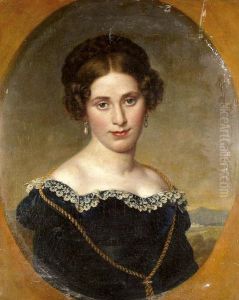Carl Jacob Th. Leybold Paintings
Carl Jacob Theodor Leybold, often simply referred to as Carl Leybold, was a German artist known for his work as a portrait painter. Born on May 18, 1813, in Stuttgart, Germany, Leybold demonstrated an early interest in art and honed his skills under the guidance of notable instructors.
In the initial stages of his career, Leybold was influenced by the styles and techniques of the German Romantic painters, which was a dominant movement at the time. However, as he developed his own artistic voice, Leybold became more focused on realism and the accurate depiction of his subjects.
Throughout his career, Leybold became well-regarded for his portraits, which were sought after by the upper echelons of society. He had the ability to capture not only the physical likeness of his sitters but also a sense of their inner life and character. This quality made his work popular among the nobility and the bourgeoise, who desired more than just a mere representation of their appearance.
Leybold's contributions to art were not limited to his paintings. He also played a role in the academic and cultural spheres, educating and influencing younger generations of artists. His legacy is preserved in the works that remain and in the development of the portrait painting genre in the 19th century.
Carl Leybold died on October 7, 1892, leaving behind a body of work that continues to be appreciated for its craftsmanship and psychological depth. His paintings can be found in various art collections and museums, serving as a testament to his skill and the artistic trends of his time.
